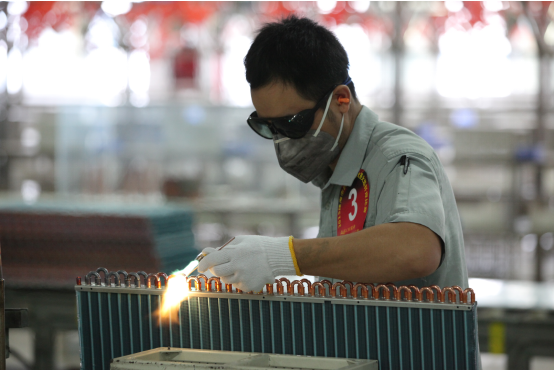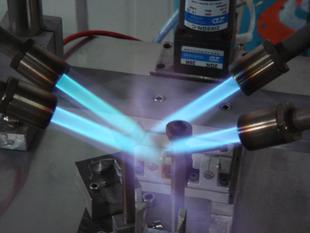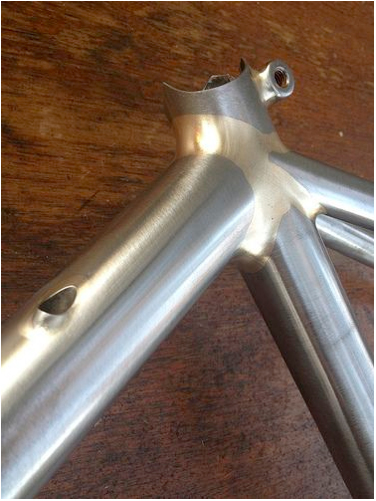Brazing refers to a welding method in which a solder and a weldment lower than the melting point of the weldment are simultaneously heated to the melting temperature of the solder, and the gap between the solid workpieces is filled with the liquid solder to connect the metal. In brazing, the oxide film and oil stain on the contact surface of the base metal are first removed to facilitate the capillary action after the solder is melted, and the wettability and capillary fluidity of the solder are increased. Brazing is divided into brazing and soldering according to the melting point of the solder.
The brazing deformation is small, the joint is smooth and beautiful, and it is suitable for welding precision, complex and components composed of different materials, such as honeycomb structural plates, turbine blades, carbide tools and printed circuit boards. Before the brazing, the workpiece must be carefully processed and strictly cleaned to remove oil and excessively thick oxide film to ensure the interface assembly gap. The gap is generally required to be between 0.01 and 0.1 mm.
Compared with fusion welding, the base metal does not melt during brazing, and only the brazing material melts;
Compared to pressure welding, no pressure is applied to the weldment during brazing.
The weld formed by brazing is called a braze.
The filler metal used for brazing is called a brazing filler metal.

Brazing process: The surface-cleaned workpieces are assembled together in a lap type, with the brazing material placed near the joint gap or between the joint gaps. When the workpiece and the brazing material are heated to a temperature slightly higher than the melting point of the brazing filler metal, the brazing material melts (the workpiece is not melted), and is sucked into and filled with the gap between the solid workpieces by capillary action, and the liquid brazing material and the workpiece metal mutually diffuse and dissolve. After the condensation, a brazed joint is formed.
Brazing application
Brazing is not suitable for the welding of general steel structures and heavy-duty, dynamic-loaded parts. Mainly used in the manufacture of precision instruments, electrical components, dissimilar metal components and complex thin-plate structures, such as sandwich components, honeycomb structures, etc., also used to braze all kinds of different wire and carbide tools. During brazing, after the contact surface of the brazed workpiece is cleaned, it is assembled in a lap joint manner, and the solder is placed near the joint gap or directly into the joint gap. When the workpiece is heated with the solder to a temperature slightly above the melting temperature of the solder, the solder will melt and wet the surface of the weld. The liquid solder spreads along the joint by capillary action. Then, the brazing metal and the brazing filler metal dissolve each other and penetrate each other to form an alloy layer, and after condensing, a brazing joint is formed.
Brazing has been widely used in machinery, motors, instruments, radios and other departments. Carbide tools, drilling bits, bicycle frames, heat exchangers, ducts and various types of containers; brazing is the only possible connection method in the manufacture of microwave waveguides, tubes and electronic vacuum devices.
Brazing characteristics
First, the surface of the joint is smooth, airtight, stable in shape and size, and the microstructure and properties of the weldment are not changed much, and the same or different metals and some non-metals can be connected. When brazing, it is also possible to heat the entire workpiece and weld a lot of welds at a time, which improves productivity. However, the strength of the brazed joint is low, and the lap joint is often used to increase the joint strength by increasing the lap length; in addition, the preparation work before brazing is required to be high.
The second is that the solder melts and the weldment does not melt. In order to make the brazing portion firmly connected and enhance the adhesion of the brazing material, a flux is used in the brazing to remove the oxide on the brazing material and the surface of the weldment. Brazing filler metal (such as copper base, silver base, aluminum base, nickel base, etc.) has high strength and can be connected to load-bearing parts for a wide range of applications, such as carbide tools and bicycle frames. Solder (such as tin, lead, antimony, etc.), low welding strength, mainly used for welding weldments that do not bear the load but require good sealing, such as containers and instrument components.
Brazing uses an alloy with a lower melting point than the base material as the brazing material. When heated, the brazing material melts and is filled and held in the joint gap by wetting and capillary action, while the base metal is in solid state, relying on liquid brazing material and solid mother The interdiffusion between the materials forms a brazed joint. Brazing has little influence on the physical and chemical properties of the base metal, and the welding stress and deformation are small. The dissimilar metals with different welding properties can complete multiple welds at the same time. The joint appearance is neat and tidy, the equipment is simple, and the production investment is small. However, the brazed joint has low strength and poor heat resistance.

Classification
(1) Soldering: The soldered solder has a melting point of less than 450 ° C and a low joint strength (less than 70 MPa).
Soldering is commonly used in the welding of conductive, airtight and watertight devices in the electronics and food industries. Soldering with tin-lead alloy as the brazing material is most commonly used. Solder generally requires a flux to remove the oxide film and improve the wetting properties of the solder. There are many types of fluxes, and the electronics industry mostly uses rosin alcohol solution for soldering. The flux after soldering has no corrosive effect on the workpiece and is called a non-corrosive flux. The flux used for welding copper, iron and other materials is composed of zinc chloride, ammonium chloride and petrolatum. Fluoride and fluoroborate are used as fluxes for the welding of aluminum, and hydrochloric acid plus zinc chloride is used as the flux. The residue after soldering of these fluxes has a corrosive effect, called a corrosive flux, which must be cleaned after soldering.
(2) Brazing: The brazing filler metal has a melting point higher than 450 ° C and a higher joint strength (greater than 200 MPa).
Brazed joints have high strength and some work at high temperatures. Brazing solders are available in a wide variety of applications, with aluminum, silver, copper, manganese and nickel based solders being the most widely used. Aluminum-based solders are commonly used for brazing aluminum products. Silver-based and copper-based solders are commonly used for brazing of copper and iron parts. Manganese-based and nickel-based brazing fillers are often used to weld stainless steel, heat-resistant steel and high-temperature alloys that work at high temperatures. Soldering materials such as ruthenium, titanium, zirconium, refractory metals, graphite, and ceramics are commonly used as solders such as palladium, zirconium, and titanium. When selecting solder, consider the characteristics of the base material and the requirements for joint performance. The brazing flux is usually composed of a chloride and a fluoride of an alkali metal and a heavy metal, or a borax, a boric acid, a fluoroborate or the like, and can be formed into a powder, a paste or a liquid. Lithium, boron and phosphorus are also added to some solders to enhance their ability to remove oxide film and wet. After soldering, the flux residue is cleaned with warm water, citric acid or oxalic acid.
Note: The contact surface of the base metal should be very clean, so use flux. The function of the flux is to remove oxides and oil impurities on the surface of the base metal and the solder, to protect the contact surface of the solder and the base material from oxidation, and to increase the wettability and capillary fluidity of the solder. The melting point of the flux should be lower than that of the solder, and the flux residue should be less corrosive to the base metal and the joint. The flux commonly used for soldering is a rosin or zinc chloride solution, and the usual flux for brazing is a mixture of borax, boric acid and basic fluoride.
Process method
The main process parameters of the brazing process are the brazing temperature and the holding time, that is, the amount of heat absorbed. The brazing temperature is usually chosen to be 25 - 60 ° C above the liquidus temperature of the solder to ensure that the solder fills the gap.
The brazing holding time depends on the size of the workpiece and the severity of the interaction between the brazing material and the parent metal. The holding time of large parts should be longer to ensure even heating. The solder has a strong interaction with the base metal and the holding time is short. In general, a certain holding time is necessary to promote the mutual diffusion of the brazing filler metal and the parent metal to form a firm bond. However, excessively long holding time will cause defects such as corrosion. There are many common methods of brazing, mainly based on the equipment used and the working principle. If it is divided by heat source, there are infrared, electron beam, laser, plasma, glow discharge brazing, etc.; according to the working process, there are contact reaction brazing and diffusion brazing. Contact-reaction brazing is the use of a brazing material to react with a parent metal to form a liquid phase filling joint gap. Diffusion brazing is to increase the thermal diffusion time, so that the weld and the base material are sufficiently homogenized to obtain the same joint performance as the base material. Almost all heating sources can be used as a source of brazing heat, and the brazing is classified accordingly:
Soldering iron brazing Soldering for small, simple or thin parts.
Wave soldering For assembly and soldering of high-volume printed circuit boards and electronic components. When welding, the molten solder at about 250 °C forms a peak through the slit under the pressure of the pump, and the workpiece is welded by the peak. This method is highly productive and enables automated production on the assembly line.
Flame Brazing A flame that is combusted by combusting a combustible gas with oxygen or compressed air is used as a heat source for welding. The flame brazing equipment is simple and easy to operate, and can be heated and welded simultaneously by multiple flames according to the shape of the workpiece. This method is suitable for the welding of medium and small parts such as bicycle frames and aluminum kettle mouths.
Dip-dip brazing The part or the whole of the workpiece is immersed in a solder bath covered with flux or a salt bath having only a molten salt for heat welding. This method is uniform, rapid, and accurate in temperature control, and is suitable for mass production and welding of large components. The salt in the salt bath is mostly composed of a flux. A large amount of flux remains on the workpiece after welding, and the cleaning workload is large.
Induction brazing is a welding method that uses high frequency, intermediate frequency or power frequency induced current as a heat source. High frequency heating is suitable for welding thin walled pipe fittings. Coaxial cable and split-type induction coils can be used for brazing on the ground away from the power supply, especially for some large components, such as the welding of pipe joints that need to be disassembled on the rocket.
Brazing in the furnace The workpiece with the brazing material is placed in the furnace for heating and welding. It is often necessary to add flux, or it can be protected by reducing gas or inert gas, and the heating is relatively uniform. Furnace brazing can be divided into box brazing furnace, well brazing furnace, batch brazing furnace and continuous brazing furnace. Continuous furnaces can be used for mass production.
The vacuum brazed workpiece is heated in a vacuum chamber and is mainly used for welding high quality products and oxidizable materials.
Post-weld cleaning
Most of the flux residue corrodes the brazed joint and also hinders the inspection of the braze joint, which often needs to be cleaned.
The rosin-containing active flux residue can be removed with an organic solvent such as isopropyl alcohol, alcohol or trichloroethylene.
A flux composed of an organic acid and a salt is generally soluble in water and can be washed with hot water. A solder composed of a mineral acid is dissolved in water and thus can be washed with hot water. A flux containing an alkali metal and an alkaline earth metal chloride such as zinc chloride can be washed with a 2% hydrochloric acid solution.
The borax and boric acid flux residues for brazing are substantially insoluble in water and are difficult to remove, and are generally removed by sand blasting. A preferred method is to place the brazed workpiece into the water in a hot state to cause the flux residue to crack and be easily removed.
The residue of the fluorine-containing potassium borate or potassium fluoride hardener (e.g., agent 102) can be boiled or removed in 10% citric acid hot water.
The aluminum residue can be removed with an organic solvent such as methanol.
The aluminum hard residue is highly corrosive to aluminum and must be removed after brazing. The cleaning methods listed below can give better results.
(1) Soak in hot water at 60-80 °C for 10 min, carefully clean the residue on the brazing joint with a brush, rinse with HNO3 15% aqueous solution in cold water for about 30 minutes, then rinse with cold water.
(2) 60-80 ° C flowing hot water rinse 5 -10min placed in 65 ~ 75 ° C, CrO32%, H3RO45% aqueous solution soaked for 15min, and then rinsed with cold water.

Quality inspection
The defect brazing of the brazed joint and its causes are as follows:
1. Poor interstitial, part of the gap is not filled
cause:
(1) The joint design is unreasonable, the assembly clearance is too large or too small, and the parts are skewed during assembly.
(2) The flux is not suitable, such as poor activity, the difference between the melting temperature of the flux and the brazing filler metal is too large, the flux filling ability of the flux is poor, etc.; or the gas purity during gas brazing is low, and the vacuum degree during vacuum brazing is low.
(3) improper selection of solder, such as poor wetting of solder, insufficient amount of solder.
(4) Improper placement of solder.
(5) Poor preparation before brazing, such as cleaning is not clean.
(6) The brazing temperature is too low or unevenly distributed.
2. Brazing vents
cause:
(1) The joint gap is not properly selected.
(2) The parts are not cleaned before brazing.
(3) The flux removal effect of the flux or the protective gas deoxidation is weak.
(4) The brazing material precipitates gas during brazing or the brazing material is overheated.
3. Brazing joint slag
cause:
(1) The amount of flux used is too much or too little.
(2) The joint gap is not properly selected.
(3) The solder fills the joint from both sides of the joint.
(4) The melting temperature of the solder and the flux does not match.
(5) The flux has a large specific gravity.
(6) Uneven heating.
4. Brazing joint cracking
cause:
(1) Since the thermal expansion coefficients of the different parent materials are different, the internal stress formed during the cooling process is excessive.
(2) The brazing of the same material is unevenly heated, resulting in inconsistent shrinkage during cooling.
(3) When the solder solidifies, the parts are displaced from each other.
(4) The solder crystallization temperature interval is too large.
(5) The brittleness of the brazing seam is too large.
5. Solder loss
cause:
(1) The brazing temperature is too high or the holding time is too long.
(2) The solder is improperly placed so as not to have a capillary action.
(3) The local gap is too large.
6. The base metal is dissolved
cause:
(1) The brazing temperature is too high and the holding time is too long.
(2) The effect between the base metal and the brazing material is too strong.
(3) The amount of solder is too large.

